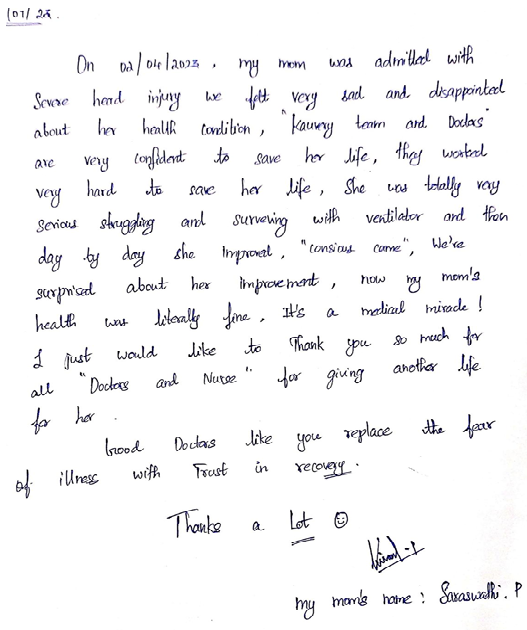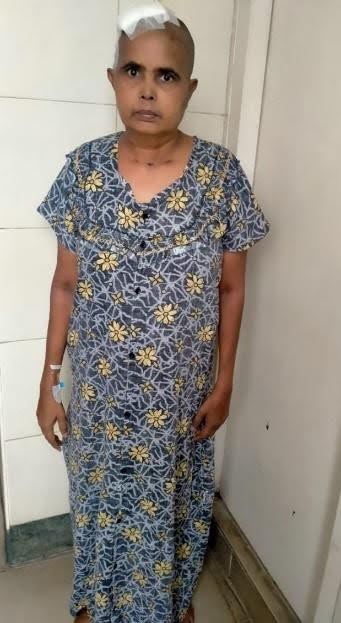Incredible challenges and outcomes: A case report
Arputhamary. Y*
Assistant Nursing Superintendent, Kauvery Hospital, Tennur, India
*Correspondence: maha@kauveryhospital.com
Background
Head Injury is considered to be the major cause of death in road traffic accident. According to the WHO about 1.24 million deaths occur due to road traffic crashes. During the year 2021, a total number of 4,12,432 road accidents have been reported in the country, claiming 1,53,972 lives and causing injuries to 3,84,448 persons.
Unfortunately, the worst affected age group in road accidents is 18-45 yr, which accounts for about 67 percent of total accidental deaths. Particularly, the treatments for head injury in the older aged people seems to be more complicated when compared to younger and middle age groups.
Road traffic accident (RTA) victims also suffer from different types of injuries and disabilities, which can affect their quality of life. They usually face with various physical, mental, and social problems. Most traffic accident victims have difficulty in returning to normal life.
Case Presentation
On 02/04/2023 our ER Department was quiet and calm which is a very rare situation on a regular Sunday. Suddenly there was a siren sound, following which we received a patient, who was brought by an ambulance.
A woman while riding on a motorbike as a pillion rider with her son, fell down as she lost her balance after her saree got entangled in the vehicle’s rear wheel chain resulting in severe head injuries.
On Examination
On arrival at ER, patient was unconscious, with low GCS 5/15. Frothy bloody secretion in the mouth was noted. In view of low GCS and to protect the airway, patient was intubated immediately and connected to Mechanical Ventilation.
Airway: Stablished with endotracheal intubation.
Breathing: Connected to ventilator support,
RR – 26 per min, SPO2 – 98 % in Fio2 -100%.
Circulation: BP – 90/60 mmHg, fluids were rushed.
Disability: Low GCS, Pupils – 1 mm ERTL B/L.
Exposure: On exposing the patient had chills & rigor for which she was managed with warmer, blankets and warm IV fluids.
In-view of bloody oral secretions, she was managed with Inj. Tranexa 1 gm IV stat, Blood transfusion was planned and transfused in view of suspicion of significant blood loss. After stabilization, patient was shifted to Radiology for CT brain, to know the status of the brain.
Investigations
CT findings
- Fracture right Temporo Parietal & left Temporo parietal bones.
- Fracture right maxillary sinus with hemopneumo sinus.
- Thin SDH Right temporal region
- Large EDH, Frontoparietal region Lt side with multiple hemorrhagic contusions
- Diffuse SAH
- Brain stem compression
- Diffuse cerebral edema with pneumo cephalous.
Management and Care
- She was recognized to be a staff of our Kauvery Hospital as a radiographer in charge. (The administration was very supportive, she was cleared for admission & further management).
- Poor prognosis was explained to patient attenders and the need for ICU support with mechanical support was also insisted. In spite of poor guarded prognosis and affordability issues, patient attenders (2 sons) had so much confidence on the clinical team, they expressed “If not this hospital, who else can save her?
- With their confidence on us, she was admitted in the ICU with continuous critical care close monitoring.
- Next day repeat CT was taken which showed increase in size of Hemorrhagic contusion right tempero occipital region with mass effect, in which she was taken immediately to decompressive craniotomy surgery and temporal lobectomy along with cisternotomy was done.
- In view of prolonged mechanical ventilator support, tracheostomy was insisted and the attenders also were ready to proceed with it and it was done on the same day of decompressive craniotomy.
- Postoperatively, patient was drowsy and clinical status worsened. Repeat CT was taken on 9th day which showed post op bony defect RTP regions, resolving hemorrhagic contusions and resolving SAD. Reduction of EDH density was seen when compared to previous CT (resolving).
- In view of worsening clinical deterioration, Left frontal craniotomy, EDH, SDH evacuation were done. Meanwhile during the ICU stay patient also developed fever and CSF Rhinorrhea. Blood cultures were taken and reported as normal. Tracheal culture showed acinetobacter which was sensitive to Meropenam.
- After her overall stay in the ICU for around 20 days, Patient started showing improvements in clinical status with GCS – E2V5M5. Patient started to obey commands and slowly weaned off from ventilator support then put on “T†piece ventilation on/off, which she well tolerated. She was shifted to ward with a length of stay of 10 days. She was planned for discharge with GCS – E4VTtM6 and moving all 4 limbs.
Discussion
- It was a great miracle! With overall stay of 34 days at the hospital, patient showed more encouraging signs of recovery and the outcome was really amazing.
- In view of initial presentation, CT – findings with severe head injury so she was expected to be in a vegetative state. With the help of multiple level of care starting from ER, ICU, Neurosurgery, and with best nursing care, the outcome of the patient was very good. Even though patient was HbsAg positive all the staffs took great care of the patient and also themselves by using personal protective equipment (PPE).
- ER management, which was the initial phase of resuscitation in a patient, was well managed by securing the airway, initial resuscitation with IV fluids and blood transfusion which stabilized the hemodynamic status of the patient.
- ICU played a major part in maintaining and managing with mechanical ventilation support to improve the lung function and in the prevention of sepsis.
- Neurosurgery, they took the correct decision at the right time and intervened in managing the complications appropriately. In giving adequate counselling to the relatives and on the need of early tracheostomy, multiple successful surgery attempts etc.
- Nurses played an important role throughout the hospital stay, to manage her physical needs, administer medications and treatment at right time, prevent bedsore and arrange chest physio. Nurses have maintained excellent verbal and written communication channels with physicians and other healthcare providers and they gave clear, concise communication to their family members. Early notification to the doctors by the staff about the status, and acute changes in status helps better outcome for the patient.
- Special care and proper attention were given by the Medical administrator, Doctors, Nursing departments and all employees of kauvery hospitals with frequent visits, which brought back her to life and to work in our hospitals again.
Praising Notes from the Attender


Mrs. Saraswathy

Arputhamary. Y
Assistant Nursing Superintendent, Kauvery Hospital, Tennur.
